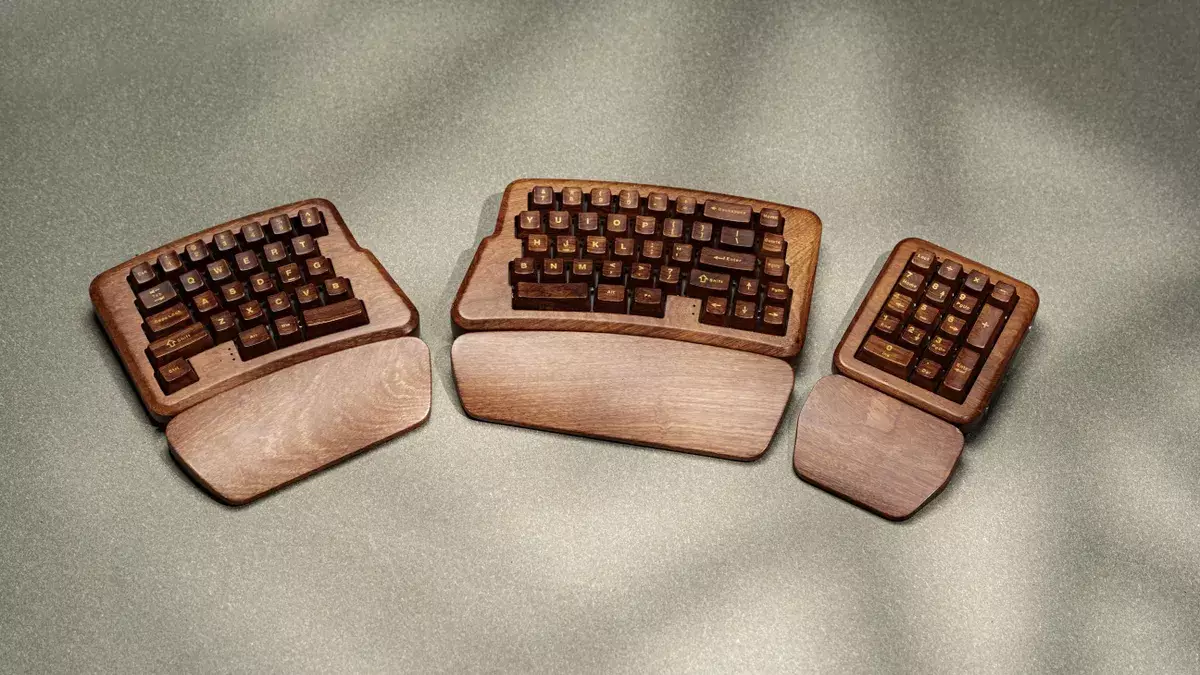When it comes to the world of tech and gadgets, keyboards seem to be an overlooked component, often receiving less attention than cutting-edge gaming mice or powerful graphics cards. However, the rise of ergonomic designs has shifted this perspective somewhat. Enter the Epomaker x Feker Alice 60 – a keyboard that attempts to marry ergonomic functionality with aesthetics derived from nature. But how does it hold up in both performance and personal comfort?
First Impressions: Controversy in Design
At first glance, the Epomaker x Feker Alice 60 is polarizing. The ergonomic split design promises to promote better posture and reduce hand strain, but its wood construction raises eyebrows. The aesthetic appeal of wood can be subjective; some may find it charming and rustic while others might consider it an odd, unorthodox choice for a high-tech input device. This discrepancy illustrates the complexities involved in product design — particularly when personal taste is as diverse as the user base itself.
Despite initial skepticism surrounding its appearance, the keyboard’s ethos embraces a naturalistic premise. While I strive to remain open-minded, it was hard to suppress the misgivings about typing on wooden keycaps. The tactile experience is likely to differ significantly from traditional plastic alternatives. For some, the unique sensation could enhance the typing experience; for others, it might simply feel unrefined or impractical.
One of the claims made by the product description states that wooden keyboards produce a quieter typing experience due to the natural sound-dampening properties of wood. This warrants an exploration into how materials influence acoustic profiles in keyboards. While the idea of a quieter keystroke is appealing, especially in a professional or shared workspace, it remains to be seen if the sound produced is genuinely more pleasant or merely softer.
The comparison to concert halls is intriguing: similar to how these halls are designed for optimal sound reflection, the wooden chassis of this keyboard aims to create an auditory experience that soothes rather than grates on the nerves. Still, the subjective nature of sound means that personal opinions will vary greatly. The muted thuds and clacks may appeal to some, while others may find it lacking in satisfying feedback.
Ergonomics and Connectivity: A Balancing Act
Functionality is another key area where the Alice 60 seeks to impress. The split design and detachable numpad may attract users who benefit from customizable space on their desks. Ergonomics is a hot topic among professionals who spend excessive time typing, and this design philosophy attempts to address common concerns about repetitive strain injuries.
For those who have not found success with split keyboards in the past, the effectiveness of this design remains uncertain. Personal comfort is paramount when considering an ergonomic setup, which often means trial and error. However, for users who have adopted this layout, the advantages can be substantial when it comes to posture and reducing discomfort.
On the tech side, the inclusion of USB Type-C connectivity and a option for 2.4 GHz wireless connection reflects modern standards. These are essential features for today’s users who value convenience and versatility in their devices. However, the inclusion of these features should have been coupled with a quantifiable benefit that justifies the steep price tag of $549, which is notably higher than many competitors on the market.
The notion that the Alice 60 commands a price that is double that of some renowned ergonomic keyboards raises serious questions about its value proposition. When stacked against models that offer cutting-edge technology, such as OLED displays and responsive polling rates, the Alice 60 finds itself under scrutiny. Enthusiasts excited about unique designs must also weigh their financial commitment against performance metrics and real-world application.
In an ever-evolving market where consumers have a plethora of options at their fingertips, products that inspire intrigue can easily find themselves set against more established giants. While the Epomaker x Feker Alice 60 may appeal to niche markets driven by aesthetics, its performance and user experience must shine through for it to justify its lofty price tag.
In a blend of innovation and creative design, the Epomaker x Feker Alice 60 keyboard stands at an intersection that both intrigues and raises valid concerns. Its bold use of wood as a primary material betrays a desire to bridge technology with nature, but it also challenges established norms surrounding usability and tactile experience. The divergence in opinions among reviewers reflects the individualized experience of keyboards and underscores the importance of personal preference.
Ultimately, the success of this product will depend on user reception — not just on its aesthetic appeal, but on how it performs in a daily setting. Advancements in ergonomic design are crucial for improving user comfort, but these features must be matched with the right material and price point for a truly satisfying experience. The Alice 60 has made its statement; now it must back it up in practice.

